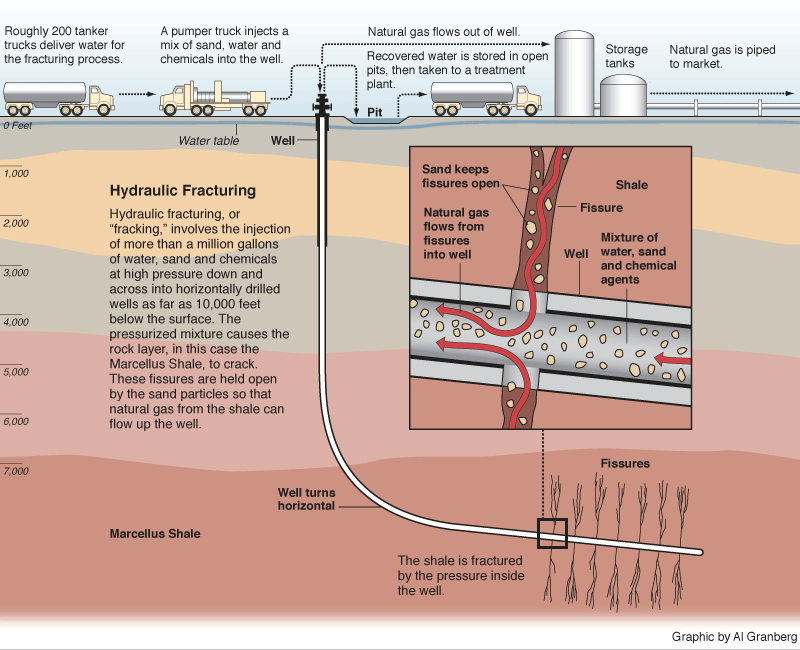Hydraulic Fracturing
| URL | Description |
|---|---|
| 60 Minutes on Hydraulic Fracturing | While some complain that extracting natural gas from shale rock formations is tainting their water supply, others who have allowed drilling on their property are getting wealthy. Lesley Stahl reports. |
| Chevron Oil Shale Project | |
| DecisionSpace Stimulation for Fracture Monitoring Software | Oil and gas companies deploy numerous technologies to optimize the performance of unconventional reservoirs. To increase returns from new shale plays, for example, you can monitor and adjust hydraulic stimulation treatments using microseismic fracture mapping. With our unified DecisionSpace® Desktop workspace, your engineers and geoscientists can visualize and analyze frac operations and microseismic data in real time-directly within the geologic framework. Maximize the impact of your fractures. |
| Fact Check: The truth behind fracking claims in "Promised Land" | |
| FracTracker | |
| Fracking - The Controversy Over Its Safety | There is a clear trend worldwide toward increased exploration and production of natural gas from shale and coal formations. Hydraulic fracturing is a critical technology for the petroleum industry and is not likely to disappear as a viable technological approach. Recent environmental concerns associated with fracking technology are putting heavy scrutiny on the industry. Such scrutiny is expected to lead to regulatory and industry practice changes that provide additional information, safeguards, and oversight that assures the technique is executed in a responsible manner. |
| Fracking across the United States | |
| Fracking fuels water fights in nation's dry spots | |
| Halliburton Policy Issues: Hydraulic Fracturing |
|
| Halliburton lays off 1000 people | |
| Hands off Hydraulic Fracturing | The shale energy boom has been a job-creating star in a grey economy. The August jobs numbers show that oil and gas extraction payrolls grew by 1,100 employees to 197,300 on a seasonally adjusted basis, up 0.6% from July and nearly 12% from a year ago. Much of this is because of hydraulic fracturing. Jobs are being created in North Dakota and other parts of the country, including jobs supporting hydraulic fracturing. [Check out Shale Works for US to learn more.] |
| Hickenlooper on oil and gas drilling | Governor John Hickenlooper Thursday praised state oil and gas regulators for passing the toughest hydraulic fracturing chemical disclosure rule in the country and warned against proposed legislation that would give local governments more authority over drilling. |
| Hydraulic Fracturing Information | Hydraulic fracturing (aka “fracing”) has been used by the natural gas and oil industry since the 1940s. In Colorado by the 1970’s fracing became a routine completion technique for most wells. When properly conducted, modern fracing is a safe, sophisticated, highly engineered and controlled procedure. Because of the public’s interest in and concern about the potential impacts of fracing on public health and the environment, including surface and ground water resources, the COGCC has compiled the documents and links listed below. We hope that you find this information useful in helping to understand more about fracing: what it is, why it is done, how it is regulated, and how the public and environment are protected. |
| MIT: Future of Natural Gas | The Future of Natural Gas is the fourth in a series of MIT multidisciplinary reports examining the role of various energy sources that may be important for meeting future demand under carbon dioxide emissions constraints. In each case, we explore the steps needed to enable competitiveness in a future marketplace conditioned by a CO2 emissions price. Often overlooked in past debates about the future of energy in the U.S., natural gas is finding its place at the heart of the energy discussion. Natural gas is a major fuel for multiple end uses — electricity, industry, heating — and is increasingly discussed as a potential pathway to reduced oil dependence for transportation. In addition, the realization over the last few years that the producible unconventional gas resource in the U.S. is very large has intensified the discussion about natural gas as a "bridge" to a low-carbon future. |
| The Benefits of Shale Gas Far Outweigh the Negatives of Fracking | In closing, it’s a desirable goal to rebalance our economy’s energy production and consumption from fossil fuels to cheap clean fuels. For this to happen, our government must enact a true clean energy policy and aggressively fund related programs. It’s clear that this is not in the cards. In the meantime, the U.S. has little choice but to leverage its abundant natural gas reserves as a transitional bridge until such time that our government “walks the talk.” Shale gas is transformative and can play a major role towards achieving energy security, economic prosperity and a cleaner environment. This will buy time while renewable energy develops into an economically reliable source of energy. Until our law makers wake up to the realities of their fiddling while we continue to burn dirty fossil fuels, these environmental and health issues will continue to plague our society. |
| What is Hydraulic Fraturing |  |
| Wikipedia Hydraulic Fracturing |  |